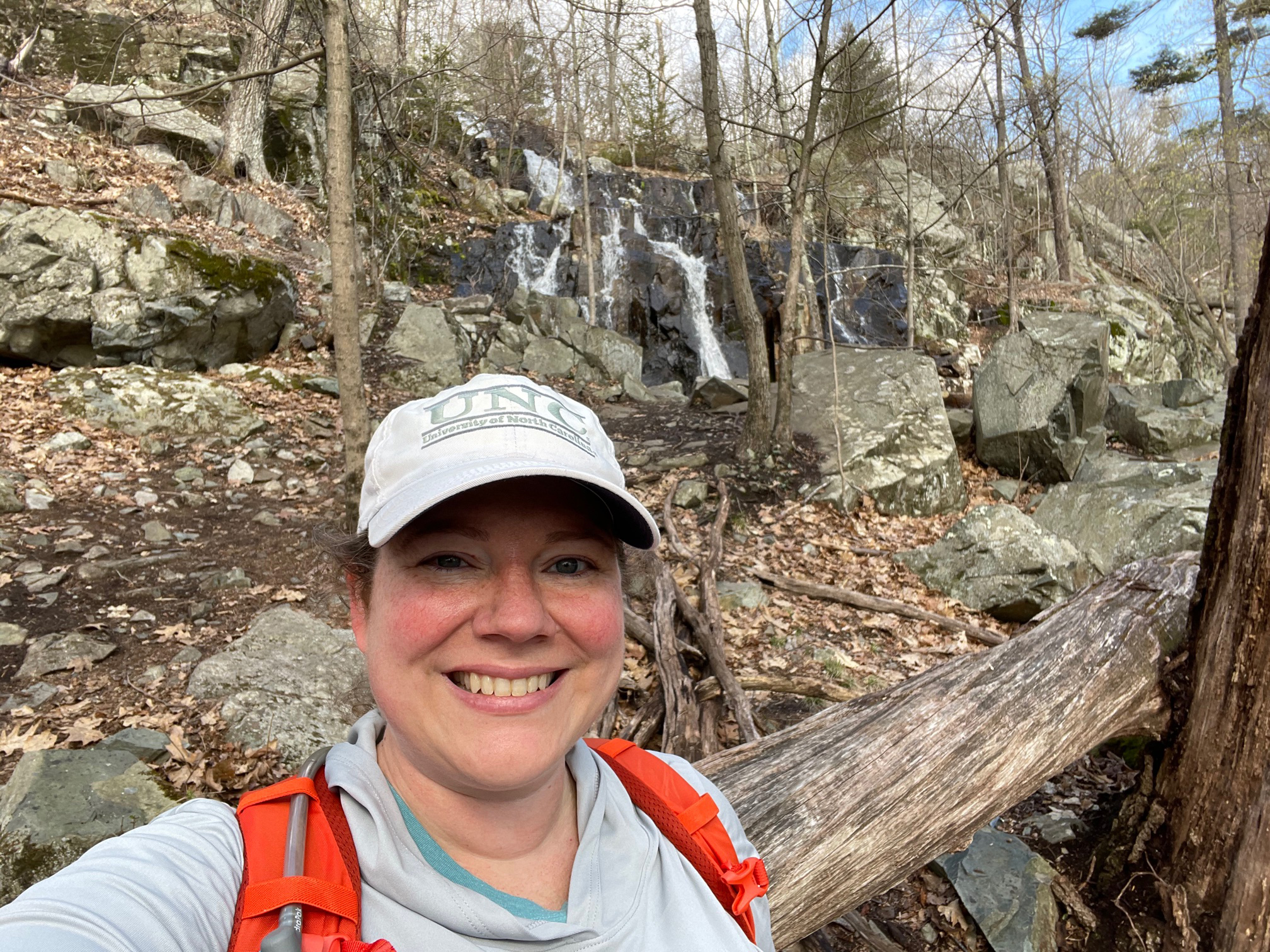
An avid hiker, Molly Jarman is pictured here on the Cascade and Rock Circuit trails in Middlesex Fells, doing her part to raise funds for the Stepping Strong B.A.A. 5K last spring.
Harnessing the Power of Injury Prevention Efforts Through Research, Education, and Community Outreach: A Conversation with Molly Jarman, PhD, MPH
In addition to directing the Stepping Strong Injury Prevention program, Molly Jarman, PhD, MPH, is a lead investigator at the Center for Surgery and Public Health and an assistant professor at Harvard Medical School. Her research addresses trauma surgery and emergency medical services, with primary interest in trauma system organization and access to care for underserved populations. Cheryl Lang and Donna Woonteiler spoke with Jarman about her focus on multifaceted, multidisciplinary approaches to preventing injuries.
Q: Thanks for talking with us, Molly. To start with, how do you define injury prevention?
A: If we use the technical definition of “injury” as an external force transferring energy to the body, then “injury prevention” is a way of preventing or mitigating the harm caused by that energy.
Q: Are all injuries preventable? Even those caused by natural disasters?
A: The short answer is yes. While natural phenomena such as earthquakes and hurricanes are not readily preventable, the injuries they cause are preventable with appropriate intervention, such as flood and fire mitigation plans, robust building codes, and timely evacuations. From a public health perspective, all injuries—including those caused by traffic crashes, falls, and substance use—are preventable through a multidisciplinary approach. The CDC describes a four-pronged systematic process to meet this challenge: (1) defining the problem; (2) identifying risk and protective factors, (3) developing and testing prevention strategies, and (4) assuring widespread adoption.
Q: How did you come to have a passion for the field of injury prevention?
A: In college, I was an orientation leader at the University of North Carolina. In that role, I taught students how to stay safe and healthy by limiting their alcohol and drug use, not getting hurt, and so on. That led me to an interest in health education, followed by a cancer research career, but my interests always came back to injury prevention and trauma care. I eventually went to Johns Hopkins to get a PhD in health policy. It was there that I learned evidence-based solutions to preventing the burden of injuries, advancing policy, and improving health equity for different communities.
Q: Given that evidence-based solutions do exist, and the fact that robust systems are in place to prevent injuries, why do so many injuries occur? And what population is at the greatest risk of getting injured?
“Many injury prevention efforts rely on community education and awareness, but it’s difficult to change individual behaviors through education alone. The most impactful prevention interventions involve changes to policies as well as improvements to the design of our physical environment that enable safe behaviors and healthy living.”
A: Many injury prevention efforts rely on community education and awareness, but it’s difficult to change individual behaviors through education alone. Many injury prevention efforts rely on community education and awareness, but it’s difficult to change individual behaviors through education alone. The most impactful prevention interventions involve changes to policies as well as improvements to the design of our physical environment that enable safe behaviors and healthy living.
The burden of injuries is unequally distributed across communities. Many disparities—social, economic, environmental, and structural—contribute to differences in health outcomes. For example, people with less income are at a higher risk of injuries than those who are better off due to occupational and environmental exposures. Those who live in rural communities don’t have the same access to quality services as people who live in urban centers. These patterns intersect with other inequities in healthcare, and disproportionately impact racial and ethnic minorities.
The challenge has been further impacted by the pandemic. One striking example is the alarming spike in drowning deaths this summer, which are 100 percent preventable. Experts are attributing this to disruptions in regular routines, closures of community pools, less access to swim lessons, and lack of lifeguards and parent supervision.
Q: How is the Stepping Strong Injury Prevention program attempting to address disparities and lessen the burden of injury?
A: Fortunately, the Brigham already has great programs in place to prevent injuries before they occur and to provide world-class treatment when they do occur. The Bridge Clinic, our Violence Prevention Program, and POPI (Program in Opioid and Pain Innovation) are a few examples.
The Stepping Strong Injury Prevention program is making a difference in several ways. We fund and facilitate research to develop new injury prevention interventions and to improve outcomes for trauma patients, we have outreach programs that raise awareness about injury and help community partners in the Greater Boston area implement prevention programs, and we provide educational opportunities at the Brigham and beyond to train the next generation of injury prevention professionals. Most importantly, we’re bringing the Stepping Strong Center culture of innovation to injury prevention and embedding novel approaches to injury prevention in all of our activities.
Q: Thanks so much for all you do, Molly. Any last thoughts?
A: The Stepping Strong Injury Prevention program is relatively young, but we’ve seen tremendous growth over the past year, despite the challenges of COVID-19 and remote work. Our growth is a testament to the Brigham community’s commitment to our patients and neighbors. We’re constantly learning about injury prevention efforts throughout the hospital. We want to harness this enthusiasm and continue building our program by fostering collaborations and partnerships. Our moonshot goal is to become a CDC Injury Control Research Center in 2023.
Learn more about the Stepping Strong Injury Prevention program.
